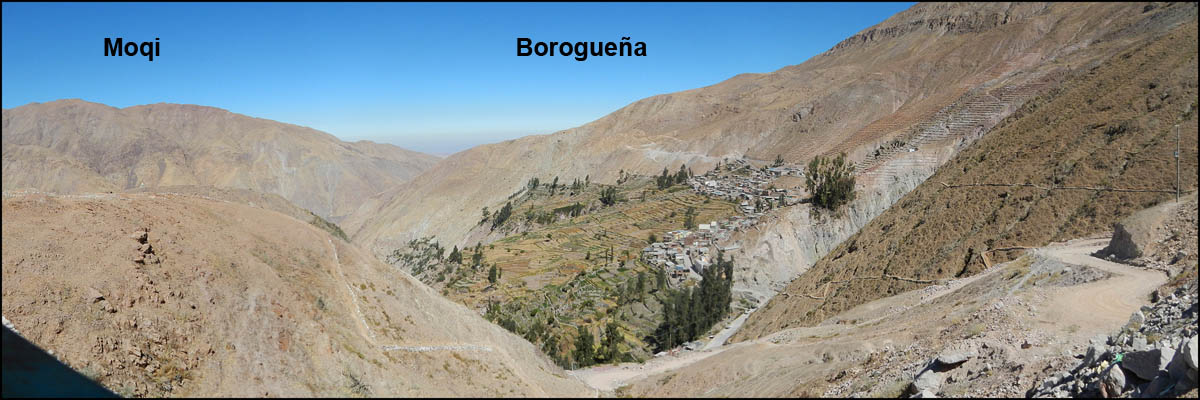| High above a tributary of the Locumba Valley, in southwestern Peru, are the remains of an Inka outpost, now identified as Moqi: |
|
Moqi Bajo is located
on a plateau behind a modern cemetery, Moqi Alto is
perched on the bluff between Cambaya and Borogueña:
|
|
|
|
|
 |
||
|
|
|
|
|
|
To complete the measured plan of the ancient remains at Moqi, between Cambaya and Borogueña in the Locumba Valley (Tacna, Peru), using both a Trimble differential GPS receiver and a Topcon total station; to provide assistance setting up this new project; and to instruct undergraduate students in the use of the survey instruments and related software (Foresight, AutoCAD, ArcGIS). | |
|
|
July 2012 |
|
|
|
Students, staff and faculty of the Moqi Archaeological Project, directed by Jesús Gordillo and Dr Colleen Zori. | |
| Results: | |
All ancient structures at Moqi were located on a measured plan; this was combined with the available topographical maps and satellite images. Selected areas were excavated revealing mostly human remains and grave goods. |
| Approximate position and date of the site: | Moqi is an Inka outpost located about 2850 m. above sea level in a tributary of the Locumba Valley, between the modern cities of Moquegua and Tacna in southern Peru and the nearby villages of Cambaya and Borogueña. The site is located on two mountain tops, the remains on the higher one are identified as Moqi Alto and the remains on the lower one as Moqi Bajo. The former seemed to have had a ceremonial function and preserves at least one large plaza and probably an ushnu, an Inka religious site. Its possible position is now occupied by two large satellite dishes, one on top of a small concrete stucture. Moqi Bajo may have served as a residential area. The area of Moqi preserves a large number of burials, many of which have been disturbed. Moqi seems to have been active for a relatively short period between around 1440 and 1530 CE. | |
| Short description of the site: |
With the
expansion of the Inka Empire it experienced an ever
increasing need for agricultural products, including
potatoes, quinoa and maize (corn). Coming down from the
highlands, the Inka seized control over potential
productive areas in order to secure a steady stream of
food towards the heartland. One of these areas was the
region around the modern villages of Cambaya and
Borogueña, where agriculture is possible with the
construction and maintenance of terraces and irrigation
canals. These exist until modern times and were probably
already mostly in place by the time that the Inka
arrived. They exercised their control not only
militarily, but also religiously and by the
redistribution of resources and wealth. The site of Moqi
was probably constructed to facilitate and symbolize
this; it was not built on top of an earlier settlement,
nor is there evidence for a later occupation. It remains
as yet unclear where the laborers under the Inka resided
and where the center of power was located before and
after the Inka Period (1440-1530 CE). Research during
the first season concentrated on Moqi Bajo and
especially on the graves in that area. Several
undisturbed burials were discovered, all of which
contained a collection of grave goods, including ceramic
vessels, basketry and the remains of maize (corn). One
grave contained an intact mummy in a rather poor state
of preservation. Many of the recovered skulls showed
signs of deliberate cranial modification, while a set of
teeth had been carefully modified to resemble those of a
carnivore. On the surface of the site many decorated
sherds were seen, all of them in a provincial Inka
style. |
|
| Additional remarks: |
My work
in Peru would not have been possible without the Moqi Archaeological Project, the Institute for Field
Research, and the Cotsen Institute of
Archaeology. |
|
|
|
||
| HOME | ||